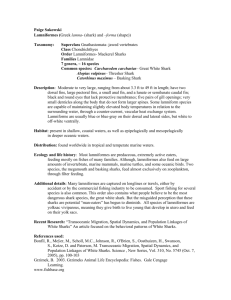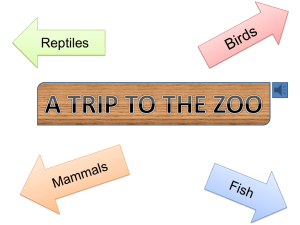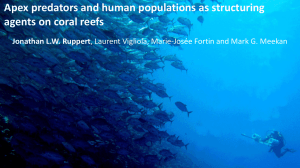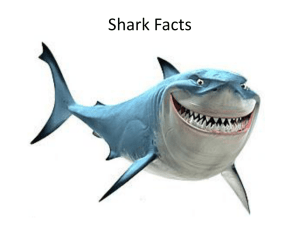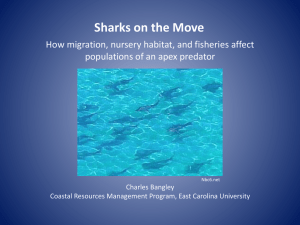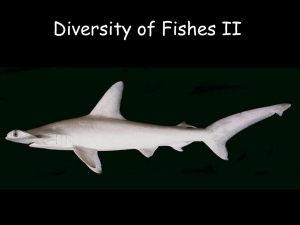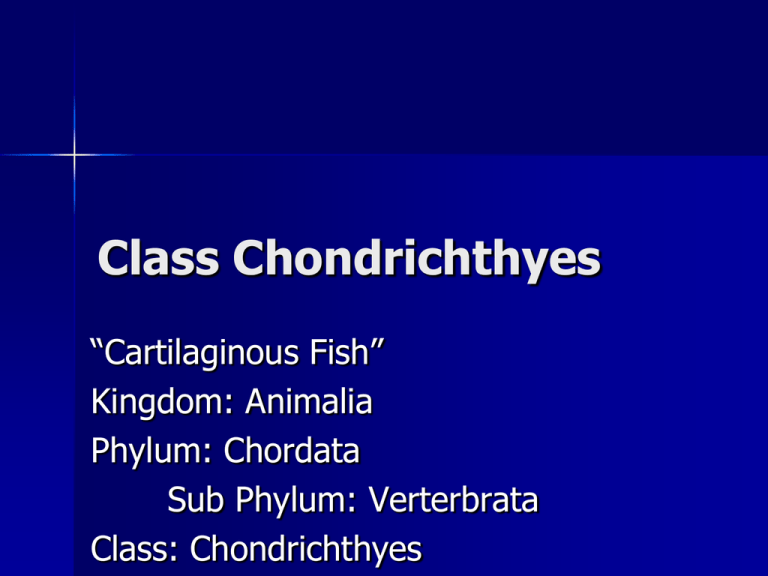
Class Chondrichthyes
“Cartilaginous Fish”
Kingdom: Animalia
Phylum: Chordata
Sub Phylum: Verterbrata
Class: Chondrichthyes
Class Chondrichthyes
Sharks, Rays,
Skates, Ratfish
Skeleton made of
cartilage
General Characteristics
Possess movable
jaws that usually
have teeth
Mouth is ventral,
underneath the
head
General Characteristics
Paired lateral fins
General Characteristics
Rough, sand paper
like skin
Made up of scales
that have the same
composition as
teeth
Ratfish / Chimaeras
Gill slits covered by
a flap of skin
Mostly deep-water
fish
Eat crustaceans and
mollusks
Skates & Rays
Flattened bodies
Dermersal – live on
the bottom
Gill slits on the
ventral side
(bottom)
Skates & Rays
Pectoral fins are flat
and expanded
Head fuses with
pectoral fins with
eyes on top
Sawfish
Ventral gill slits
Swing blade
through schools
disabling prey
Similar to saw
sharks except for
size and gill
placement
Stingrays
Equipped with a
stinging spine
Spine connected to
venomous glands
Teeth modified into
grinding plates
Manta & Devil Rays
Not bottom
dwellers instead
choose to swim
Sharks
Living Fossils
Have not needed to
evolve for 100
million years
Megalodon
Ancient shark
Largest predatory fish
ever
Twice the size of a great
white
External Structure
Paired vs. Unpaired fins
Paired: Pectoral & Pelvic
Comparable to our arms and legs
Unpaired: 1st Dorsal, 2nd Dorsal, Anal,
and Caudal
All found along mid-line
Scales
Scales are very small and sharp
Same composition as the teeth
Jaws
Made of bone
Contain the
disposable teeth
In some species
capable of
extending jaw out
from body
Teeth
Same composition
as the scales
Continually shed
and replaced by the
rows behind
Respiration
Must swim to force
water through their
gills
Some such as nurse
sharks can get
enough oxygen so
they do not need to
swim
Digestion
Very short
esophogus
Stomach can be up
to 1/3 the length of
the shark
Intestine is really
small, only about a
foot
Nervous System
Lateral line used for sensing vibrations in
the water
Nervous System
Ampullae of Lorenzini
Jelly filled canals that can detect electrical
fields, magnetic fields, temperature, salinity,
water pressure, etc.
Nervous System
Paired external
nostrils that lead
directly to the brain
Very acute sense of
smell, can detect
concentrations as
low as one part per
billion
Shark Classification
Two Super-Orders:
– Galeomorphs & Squalomorphs
Further broken down into orders
Order Heterodontiformes:
Bullhead Sharks
Pig like snout
Bottom dwellers
Order Orectolobiformes:
“Carpet Sharks”
Very short mouths
Upper lobe of
caudal fin extended
with reduced lower
lobe
Includes filter
feeders
Order Lamniformes:
“Mackerel Fish”
Larger front teeth
Include some of
most popular
Most are active
predators
Functionally warmblooded
Order Lamniformes:
“Goblin Sharks”
Mitsukurindidae
“Sandtiger Sharks”
Carchariidae
Order Lamniformes:
“Ragged-Tooth
Sharks”
Odontaspididae
“Thresher Sharks”
Alopiidae
Order Lamniformes:
“Megamouth Shark”
Megachasmidae
“Crocodile Sharks”
Pseudocarchariidae
Order Lamniformes:
“Basking Shark”
Cetorhinidae
“Mackerel Sharks”
Lamnidae
Order Carcharhiniformes:
“Ground or Whaler
Sharks”
Adaptable to many
environments, even
estuarine and
freshwater
Flappable lower
eyelids
Order Carcharhiniformes:
“Whaler Sharks”
Carcharhinidae
“Hammerhead
Sharks”
Sphyrnidae
Order Carcharhiniformes:
“Cat Sharks”
Schliorhinidae
Order Chlamydoselachi
“Frilled Shark”
Eel like body
Teeth are three
pronged
Deep water
Order Hexanchiformes
“Cow Sharks”
Deep water
Very little is known
Order Echinorhiniformes
“Bramble Sharks”
Thick tail stalk
Has bumps on skin
“hedgehog shark
Order Sqauliformes
“Dogfish Sharks”
Large ranges of sizes
Generally best known shark
Order Sqauliformes
Greenland Shark
(21 feet +)
Dwarf Laternshark
Order Squantiniformes
“Angel Sharks”
Flattened bodies
Gills on ventral side
Mouth at end rather than ventral like rays and
skates
Order Pristiophoriformes
“Sawsharks’
Similar to sawfish,
but skinnier and
have sensitive
barbs on snout
Alternating long
short teeth


